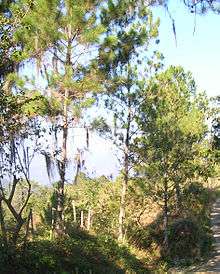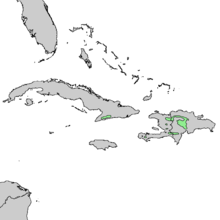Pinus occidentalis
Pinus occidentalis, or Hispaniolan pine[1] or Hispaniola pine,[2] is a pine native to eastern Cuba and the island of Hispaniola, where it is the predominant species in the Hispaniolan pine forests of Haiti and the Dominican Republic.[2] It is called pino criollo in the Dominican Republic.
| Pinus occidentalis | |
|---|---|
 | |
| Scientific classification | |
| Kingdom: | Plantae |
| Clade: | Tracheophytes |
| Division: | Pinophyta |
| Class: | Pinopsida |
| Order: | Pinales |
| Family: | Pinaceae |
| Genus: | Pinus |
| Subgenus: | P. subg. Pinus |
| Section: | P. sect. Trifoliae |
| Subsection: | P. subsect. Australes |
| Species: | P. occidentalis |
| Binomial name | |
| Pinus occidentalis | |
 | |
| Natural range of Pinus occidentalis | |
Habitat
Hispaniolan pines are found mixed with broadleaf trees from 850 to 2,100 m (2,790 to 6,890 ft), and occur in pure stands above 2,100 m (6,900 ft) up to the 3,087 m (10,128 ft) summit of Pico Duarte, the highest point on the island. They are sometimes found in the lowland Hispaniolan moist forests ecoregion, in areas where poor acidic laterite soils predominate.
Description
It is a medium-sized tree, growing to 20 to 30 m (66 to 98 ft) tall with an open crown. The leaves are dark green, needle-like, in fascicles of 3, 4, 5, 11–20 cm (4.3–7.9 in) long and 0.9–1.3 mm (0.035–0.051 in) thick. The cones are 5–8 cm (2.0–3.1 in) long, glossy brown, with a small prickle on each scale pointing forward; they mature in about 18 months and open to release the seeds, which are 4–5 mm (0.16–0.20 in) long with a 15 mm (0.59 in) wing.
Symbiotic relationships with ectomycorrhizal fungi enable Hispaniolan pines to grow on shallow, infertile soils.
The Hispaniolan crossbill feeds almost exclusively on this tree's cones.
References
- Farjon, A. (2013). "Pinus occidentalis". IUCN Red List of Threatened Species. 2013: e.T34192A2850209. doi:10.2305/IUCN.UK.2013-1.RLTS.T34192A2850209.en.
- "Pinus occidentalis / Hispaniola pine | Conifer Species". American Conifer Society. Retrieved 12 August 2020.
